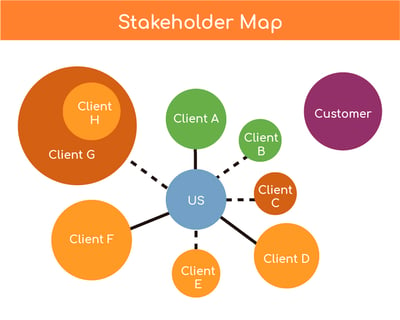
Have you ever felt that getting your boss’s approval of your brilliant new Marketing idea is mission impossible? Well, then you are not alone.
We all know that key decision-makers’ support is one of the most important factors that can influence a successful Inbound Marketing strategy implementation into your business. Unfortunately, convincing them to try out new things from the world of Marketing can be challenging sometimes. So, how to prove your stakeholders that Inbound is really worth trying? And how to get them to apply this methodology?
In this article we will answer these questions. Furthermore, we will deep-dive into who your stakeholders are, and which Marketing Management frameworks can help you win their trust.
So, who are my stakeholders?
There are different approaches to define who your stakeholders are that depend on which characteristics you take into account. The most common ways for classifying them are the following:
- External vs. Internal: Start by asking yourself whether your stakeholders are external (clients, providers) or internal (your colleagues) and what role they have in the company. It can be your CEO, CMO, CFO, Chief Editor, etc. Internal stakeholders will be your principal allies on your way to implementing inbound.
- Level of influence: We can classify the stakeholders according to the level of influence they have and to what extent implementing Inbound strategy will affect them: from those who have major influence and are very affected, to the ones who have very little influence (but who should be taken into account as well.)
- Teams: It is very useful to see which teams your stakeholders are part of and whether they belong to the same team. For example: IT-team, sales department, board of directors, etc.
- Profile: Finally, stakeholders can also be grouped by profile (technical, marketing, sales, etc.)
Why are internal stakeholders so important for me?
What is that that makes stakeholders so noteworthy for us marketers? First, they have the power to make legal, financial, and moral decisions of the company and affect its performance (in a good or bad way). Second, they can provide us with resources that are crucial to the success of our project/strategy. The stakeholders themselves can, of course, be a primary source of key information. Finally, you should not forget that your project can affect their budget or add to their responsibilities.
What challenges can arise when I try to win their trust?
The biggest obstacle you will most-likely have to overcome is the fact that the stakeholders don’t always believe that Marketing can improve the profitability or growth of the firm. But sometimes, there is more to it than that: the truth is, your stakeholders are actually human! Sometimes they don’t want to change long-standing practices because they are afraid to step out of their comfort zone. Maybe they just don’t want to be asked to do something they are unable or uncomfortable doing (especially if inbound is something very new for them). Or probably they simply might have some more personal motivations that run counter to implementing or supporting your project.
How can I convince stakeholders to support Marketing ?
There are several best practices that will help you turn the stakeholders into your allies.
First of all, use a framework for Marketing management to learn everything about the stakeholders of your firm. There are a lot of frameworks and tools for analyzing and organizing stakeholders into groups. Many of them are based on a matrix. For example, a stakeholder participation matrix can be very useful: when filling it in, you will see that your colleagues have different way of participating in your project and therefore should be addressed in a different way:
| Stakeholders to Approach by Which Means | ||||
| Inform | Consult | Involve | Collaborate | Empower |
| Promise: We will keep you informed | Promise: We will keep you informed, listen to you, and provide feedback on how your input influenced the decision. | Promise: We will work with you to ensure your concerns are considered and reflected in the alternatives considered, and provide feedback on your input influenced the decision. | Promise: We will incorporate your advice and recommendation to the maximum extent possible. | Promise: We will implement what you decide. |
Source: Researchgate
You can create and fill in matrices depending on different criteria. For instance, you can compare stakeholders’ impact with their influence. Power can be analyzed together with many different characteristics: legitimacy and urgency, influence in the organization, etc.
 Another useful format for analyzing your stakeholders is a map. A great example is a relationship, influence and feel map, created by Glenn Hughes. Use the size to represent the influence of a stakeholder, the lines to build a relationship map between them and the colors to represent their feelings (whether the engagement is strong, medium, or there is no “feeling” at all). Don’t be afraid to get creative and invent your own map! The fun part is using different lines, colors and shapes representing stakeholders and their qualities, which will help you make your analysis very visual.
Another useful format for analyzing your stakeholders is a map. A great example is a relationship, influence and feel map, created by Glenn Hughes. Use the size to represent the influence of a stakeholder, the lines to build a relationship map between them and the colors to represent their feelings (whether the engagement is strong, medium, or there is no “feeling” at all). Don’t be afraid to get creative and invent your own map! The fun part is using different lines, colors and shapes representing stakeholders and their qualities, which will help you make your analysis very visual.
Don’t forget about different Buyer Persona tools. They can be reused when creating your “stakeholder personas”.
Lastly, check out a RACI chart, which stands for Responsible, Accountable, Consulted, and Informed. It is a very powerful tool that can help you answer some very important questions like:
- What part do they play in implementing inbound strategy?
- Which responsibilities do they have?
- What decisions do they make?
- Do they have expertise in a field important for your project and should they be consulted frequently when moving forward with it?
- Should they be kept up to date with your progress?
How do I approach my stakeholders?
Okay, now you have an in-depth analysis underway. The next question you should ask at this point is: Are your stakeholders detractors or supporters? Depending on that, there are three main strategies: you can count on their support, try to convince them, or simply work around.
 The most difficult part will be presenting your idea. To make your pitch a success you should always know what you talk about and be able to explain it in simple words. Remember that inbound is probably something very new to your audience: stick to facts, show how your project will be profitable for the company and for the stakeholders themselves. Don’t forget to give examples and (very important!) present a detailed action plan. Most stakeholders will be very interested in measuring the success of your initiative, so define success metrics in advance.
The most difficult part will be presenting your idea. To make your pitch a success you should always know what you talk about and be able to explain it in simple words. Remember that inbound is probably something very new to your audience: stick to facts, show how your project will be profitable for the company and for the stakeholders themselves. Don’t forget to give examples and (very important!) present a detailed action plan. Most stakeholders will be very interested in measuring the success of your initiative, so define success metrics in advance.
What should I avoid when dealing with stakeholders?
There are some common mistakes you definitely want to avoid at all stages of your work and collaboration with stakeholders:
- Do not show them your analysis (people usually don’t like to be studied and analyzed.)
- Do not make any progress without involving stakeholders to review, give feedback and approve your project
- Consider the order in which to approach your stakeholders (e.g. consider first approaching the Head of your department before presenting your idea to the CEO). It is essential to be aware of the Marketing department structure.
- Make sure the stakeholders feel that they are part of the process: they should know they’re heard, and their opinion is acknowledged.
Stakeholders are very important for us marketers. Let’s face the truth: our job depends on them sometimes. They are not always easy to convince, especially when it comes to brand-new creative ideas, and especially if these ideas require some budget spent on them. However, getting stakeholders onboard with Inbound Marketing is not impossible: just be sure about what you’re going to suggest, prepare your strategy, analyze, and approach your stakeholders using some of the ultimate frameworks for Marketing management. And last but not least: believe in Inbound and you will get your stakeholders’ support without a doubt!
You can always count on HubSpot experts at the mbudo Inbound Marketing Agency in Madrid to help you in terms of pitching, storytelling, and useful resources. Don’t hesitate to contact us.

Anna Chizhikova
Anna holds a degree in Linguistics, and has found her vocation in the field of Inbound Marketing and Marketing Automation. She loves combining her technical and creative knowledge with her passion for languages in the day-to-day tasks. She also loves painting, reading and doing yoga in her free time.
It may interest you
LATEST
BLOG POSTS
SUBSCRIBE TO MBUDO BLOG
And get your inbound news directly in
your inbox, once a month.


